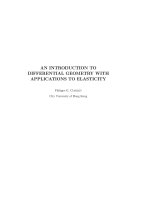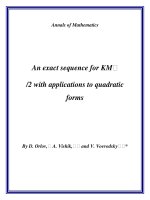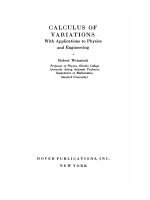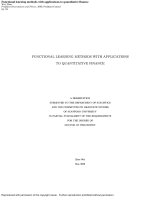Drop on demand inkjet printing technology with applications to polymer light emitting diodes
Bạn đang xem bản rút gọn của tài liệu. Xem và tải ngay bản đầy đủ của tài liệu tại đây (3.54 MB, 184 trang )
DROP-ON-DEMAND INKJET PRINTING TECHNOLOGY
WITH APPLICATIONS TO POLYMER LIGHT-EMITTING
DIODES
NG YUAN SONG
NATIONAL UNIVERSITY OF SINGAPORE
2007
DROP-ON-DEMAND INKJET PRINTING TECHNOLOGY
WITH APPLICATIONS TO POLYMER LIGHT-EMITTING
DIODES
NG YUAN SONG
(B.Eng. (Hons.)), NUS
A THESIS SUBMITTED
FOR THE DEGREE OF MASTER OF ENGINEERING
DEPARTMENT OF MECHANICAL ENGINEERING
NATIONAL UNIVERSITY OF SINGAPORE
Acknowledgements
Acknowledgements
The author would like to express his appreciation and gratitude to the following people
for their guidance and advice throughout the course of this project:
A/Prof Jerry Fuh Ying Hsi, Supervisor, National University of Singapore,
Department of Mechanical Engineering, Division of Manufacturing, for his
continuous support and trust.
Professor Chua Soo Jin, Deputy Director, Opto & Electronics Systems Cluster
(OESC), Institute of Materials Research and Engineering (IMRE) for his advice
and encouragement.
A/Prof Loh Han Tong, Co-supervisor, National University of Singapore,
Department of Mechanical Engineering, Division of Manufacturing, for his
guidance and advice.
A/Prof Wong Yoke San, Project Team Supervising Member, National University
of Singapore, Department of Mechanical Engineering, Division of Manufacturing,
for his concern and suggestions in project related issues.
Special Thanks to Dr William Birch, Senior Research Scientist, Micro- & NanoSystems Cluster (MNSC), Institute of Materials Research and Engineering for his
patience and knowledge on the finer points of Surface Science.
Mr. Jeffrey John Gray, Senior Research Engineer, SERC Nanofabrication and
Characterization Cluster (SNFC), Institute of Materials Research and Engineering,
for his technical and mathematical analysis assistance.
Mr. Zhou Jinxin, Project Team Member, National University of Singapore,
Department of Mechanical Engineering, Division of Manufacturing, for his
assistant and knowledge in carrying out the project.
Last but not least, the author would like to thank the staff of the Advanced Manufacturing
Lab (AML), Workshop 2 (WS2) and the various Laboratories and Workshops of IMRE
and NUS and their technical staff for their support and technical expertise in overcoming
the many difficulties encountered during the course of the project.
National University of Singapore
i
Table of Contents
Table of Contents
Acknowledgements .............................................................................................................. i
Table of Contents ................................................................................................................ ii
Summary .......................................................................................................................... viii
List of Tables ...................................................................................................................... x
List of Figures ................................................................................................................... xii
List of Symbols ................................................................................................................ xix
1.
INTRODUCTION ...................................................................................................... 1
1.1 Background ............................................................................................................... 1
1.2 Challenges ................................................................................................................. 3
1.3 Objectives ................................................................................................................. 4
1.4 Organization .............................................................................................................. 6
2.
LITERATURE REVIEW ........................................................................................... 7
2.1 Introduction to Inkjet Printing .................................................................................. 7
2.1.1 Classification of Inkjet Printing Techniques...................................................... 8
2.1.1.1 Continuous Inkjet Printing Methods ........................................................... 9
2.1.1.2 Drop-on-Demand Inkjet Printing Methods ............................................... 11
2.1.2 Important Parameters of Concern for Inkjet Printing Systems ........................ 17
2.1.2.1 Print System Parameters ........................................................................... 17
2.1.2.2 Print-head Parameters ............................................................................... 19
2.1.2.3 Print Material Parameters ......................................................................... 20
National University of Singapore
ii
Table of Contents
2.1.3 Advantages and Disadvantages of Inkjet Printing ........................................... 23
2.1.3.1 Advantages of Inkjet Printing ................................................................... 23
2.1.3.2 Disadvantages of Inkjet Printing............................................................... 25
2.2 Application of IJP to Polymer Light Emitting Diodes............................................ 26
2.2.1 Classification of Organic Light Emitting Diodes ............................................ 27
2.2.1.1 Small Molecule OLEDs (SMOLEDs) ...................................................... 27
2.2.1.2 Conjugated Polymer OLEDs (PLEDs) ..................................................... 27
2.2.2 Basic Structure and Working Principle of an OLED ....................................... 28
2.2.3 Indium-Tin-Oxide (ITO) Substrate Surface Treatment ................................... 31
2.2.3.1 Introduction to Surface Wettability .......................................................... 33
2.2.3.2 Brief Review of Surface Treatment Procedures and the Achieved
Wettability............................................................................................................. 37
2.2.4 Different Types of OLED Fabrication Methods .............................................. 39
2.2.4.1 Thermal Vacuum Evaporation .................................................................. 39
2.2.4.2 Wet-Coating Techniques .......................................................................... 41
2.2.4.2.1 Spin-Coating ...................................................................................... 41
2.2.4.2.2 Inkjet Printing .................................................................................... 42
3.
RESEARCH AREAS OF CONCERN ..................................................................... 43
3.1 Indium-Tin-Oxide Surface Preparation Process ..................................................... 44
3.2 Drop-on-Demand Inkjet Printing Process ............................................................... 46
National University of Singapore
iii
Table of Contents
4.
EXPERIMENTAL PROCEDURES ......................................................................... 48
4.1 Indium-Tin-Oxide Surface Preparation Process ..................................................... 48
4.1.1 Surface Cleaning .............................................................................................. 48
4.1.1.1 Equipment and Materials .......................................................................... 48
4.1.1.1.1 Equipment .......................................................................................... 48
4.1.1.1.2 Materials ............................................................................................ 49
4.1.1.2 Processes and Procedures ......................................................................... 50
4.1.1.2.1 ITO Surface Cleaning Processes ........................................................ 50
4.1.1.2.2 Contact Angle Measurement Procedures ........................................... 52
4.1.2 Surface Patterning ............................................................................................ 57
4.1.2.1 Equipment and Materials .......................................................................... 58
4.1.2.1.1 Equipment .......................................................................................... 58
4.1.2.1.2 Materials ............................................................................................ 59
4.1.2.2 Processes and Parameters ......................................................................... 59
4.2 Drop-on-Demand Inkjet Printing Process ............................................................... 66
4.2.1 Equipment and Materials ................................................................................. 66
4.2.1.1 Drop-on-Demand Inkjet Printer ................................................................ 66
4.2.1.1.1 Hardware ............................................................................................ 66
4.2.1.1.2 Software ............................................................................................. 68
4.2.1.2 Print-Head ................................................................................................. 74
4.2.1.2.1 Hardware ............................................................................................ 74
4.2.1.2.2 Piezoelectric Voltage Pulse Signal Profile ........................................ 75
4.2.1.3 Dispensed Material ................................................................................... 76
National University of Singapore
iv
Table of Contents
4.2.1.3 Other General Testing Equipment ............................................................ 77
4.2.2 Methodology Developed for Optimizing Pulse Profile Parameters ................ 78
4.2.2.1 Overview of the Methodology .................................................................. 78
4.2.2.2 Actual Design of the Methodology ........................................................... 81
4.2.3 Influence of Temperature on Profile of Printed Single Droplets ..................... 84
5.
RESULTS, DISCUSSIONS AND CONCLUSIONS ............................................... 86
5.1 Indium-Tin-Oxide Surface Preparation Process ..................................................... 86
5.1.1 Surface Cleaning .............................................................................................. 86
5.1.1.1 Results and Discussions ............................................................................ 86
5.1.1.2 Conclusions ............................................................................................... 94
5.1.2 Surface Patterning ............................................................................................ 95
5.1.2.1 Results and Discussions ............................................................................ 95
5.1.2.2 Conclusions ............................................................................................... 97
5.2 Drop-on-Demand Inkjet Printing Process ............................................................... 98
5.2.1 Methodology Developed for Optimizing Pulse Profile Parameters ................ 98
5.2.1.1 Organization of Collected Data ................................................................ 98
5.2.1.2 Response Tables and Graphs from Taguchi Analysis ............................ 101
5.2.1.2.1 Results for Drop Volume Standard Deviation ................................. 102
5.2.1.2.2 Results for Drop Velocity Standard Deviation ................................ 107
5.2.1.2.3 Results for Drop Directionality Standard Deviation ........................ 109
5.2.1.3 Prediction and Confirmation ................................................................... 111
5.2.1.3.1 Prediction Equation of Level Average Analysis .............................. 111
National University of Singapore
v
Table of Contents
5.2.1.3.2 General Regression Model ............................................................... 113
5.2.1.4 Comparison of Drop Uniformity ............................................................ 116
5.2.1.4.1 Comparison of Printed Droplets on ITO Substrate .......................... 116
5.2.1.4.2 Comparison of Standard Deviations of Drop Volume, Velocity and
Directionality .................................................................................................. 118
5.2.1.5 Conclusions ............................................................................................. 120
5.2.2 Influence of Temperature on the Profile of Printed Single Droplets ............. 121
5.2.2.1 Review of Drop Spreading and Drying Behavior ................................... 121
5.2.2.2 Results ..................................................................................................... 127
5.2.2.1.1 Simple Cap Shape ............................................................................ 127
5.2.2.1.2 Transition Shape .............................................................................. 129
5.2.2.1.3 Ring-like Shape ................................................................................ 131
5.2.2.3 Discussions and Conclusions .................................................................. 134
6.
RECOMMENDATIONS FOR FUTURE WORK ................................................. 140
6.1 Indium-Tin-Oxide Surface Preparation Process ................................................... 140
6.2 Drop-on-Demand Inkjet Printing Process ............................................................. 141
Bibliography ................................................................................................................... 142
Publications ..................................................................................................................... 146
National University of Singapore
vi
Table of Contents
Appendices .......................................................................................................................... 1
A1.1 Contact Angle Data for UV-Ozone Cleaning Process ........................................... 1
A1.2 Contact Angle Data for Oxygen-Plasma Cleaning Process ................................... 3
A1.3 Contact Angle Data for Alkaline Cleaning Process ............................................... 6
A1.4 Contact Angle Data for Neutral Cleaning Process ................................................. 9
A1.5 Contact Angle Data for Organic Cleaning Process .............................................. 13
A2.1 Dried Single Droplet Data with respect to Substrate Temperature ...................... 16
National University of Singapore
vii
Summary
Summary
Polymer Light-Emitting Diodes (PLEDs) have been traditionally produced by SpinCoating. However, the trend now is moving towards a more efficient production
technique using Drop-on-Demand Inkjet Printing (DoD-IJP) Technology. Although
prototypes have been produced successfully using this method, much work remains to be
done on using IJP for the various aspects of producing PLEDs. In this research, three
areas of work relating to PLEDs and IJP were performed. Surface wettability of IndiumTin-Oxide (ITO) substrates, which are common substrates for PLEDs, has been
characterized by contact angle measurements after been cleaned using five different
separate cleaning processes. It was concluded that dry cleaning processes are generally
more efficient than wet cleaning processes. They produce surfaces with better wettability
and uniformity by effectively removing hydrocarbon contamination. This is an important
advantage when printing droplets which require uniform substrate wettability. We
selected the dry cleaning process of Oxygen-Plasma as the standard cleaning for the ITO
substrates. Other than producing a uniformly cleaned surface with high wettability, this
surface also lasts longer after exposure to atmospheric conditions. Surface pattering of
the ITO substrates using parameters that have been identified to be repeatable and
relatively stable for the materials and machines used, have been carried out. The
patterned features that we have obtained are reasonably sharp and sufficient for our
purposes. Repeated patterning of different ITO substrates has been carried out without
encountering
any
major
problems.
Poly(ethylenedioxythiophene):Poly(styrene-sulfonate)
IJP
or
of
a
PEDOT:PSS,
material,
which
is
commonly used as the Hole-Transport-Layer (HTL) of a PLED, have been conducted.
National University of Singapore
viii
Summary
The printing was done using a print-head based on piezoelectric principles and actuated
by a voltage pulse profile signal. Using data collected from Taguchi Design of
Experiments and analyzed using Level Average Analysis we were able to obtain more
optimized pulse profile parameter settings in order to achieve droplets of better
uniformity. The preferred set of parameters that we have obtained is relatively better than
the other parameters that we have used for our investigations. However, this set is not the
best possible settings requiring further future investigation. Nevertheless, the
methodology of combining a statistical method with experiments to optimize a set of
parameters for a certain process has been demonstrated here. This methodology can be
adapted for the optimization of other experimental processes. Printing of droplets on ITO
substrates was carried out and the influence of substrate temperature on the dried profile
of single printed droplets was investigated. We have proposed an explanation as to why
such shapes were obtained and how these shapes changes with the different substrate
temperatures. Generally, at higher temperature, which leads to faster drying rate, the
small inkjet printed droplets dry almost immediately upon impact. This resulted in a
variety of dried droplet profiles with different substrate temperatures that may or may not
be desirable, depending on the final profile shape that is required. However, this
knowledge and the subsequent characterization can serve as a reference for future work
that may be undertaken to obtain specific print features that is more desirable.
National University of Singapore
ix
List of Tables
List of Tables
Table 2.1: Summary of Achieved Contact Angles from Literature. ................................. 38
Table 4.1: Parameter setting for the Oxygen-Plasma Cleaner in the final treatment. ...... 64
Table 4.2: Brief Technical and Performance Specifications of Litrex 80L inkjet
printer.[41] ........................................................................................................................ 68
Table 4.3: Brief Specifications of Spectra SX3 print-head.[42] ....................................... 75
Table 4.4: Brief Characteristics of Baytron P VP CH 8000 PEDOT:PSS.[44] ................ 77
Table 4.5: L16 (215) array used for Taguchi Design Experiment. .................................... 82
Table 4.6: Level settings for the different factors for Taguchi Design Experiment. ........ 83
Table 4.7: The 5 main control factors, their level settings and the randomization sequence
used. .................................................................................................................................. 83
Table 5.1: Summary of the Average Sessile Contact Angles. .......................................... 87
Table 5.2: Summary of the Average Advancing Contact Angles. .................................... 88
Table 5.3: Summary of the Average Receding Contact Angles. ...................................... 88
Table 5.4: Summary of the Contact Angle Hysteresis. ..................................................... 91
Table 5.5: Summary of Standard Deviation Data for Drop Volume. ............................. 100
Table 5.6: Summary of Standard Deviation Data for Drop Velocity. ............................ 100
National University of Singapore
x
List of Tables
Table 5.7: Summary of Standard Deviation Data for Drop Directionality. .................... 101
Table 5.8: Response Table for Drop Volume Standard Deviation. ................................ 103
Table 5.9: Interaction Matrix. ......................................................................................... 104
Table 5.10: Response Table for Drop Velocity Standard Deviation. ............................. 107
Table 5.11: Response Table for Drop Directionality Standard Deviation. ..................... 109
Table 5.12: Standard Deviation Results for the Confirmation Runs. ............................. 115
Table 5.13: Comparison of Confirmation to Predicted Results for P1. .......................... 115
Table 5.14: Comparison of Confirmation to Predicted Results for P2. .......................... 115
Table 5.15: Comparison of Average Standard Deviations for the TDE Runs with P1 and
P2. ................................................................................................................................... 116
Table 5.16: Comparison of a Taguchi Design Set to Preferred Set P2. .......................... 120
National University of Singapore
xi
List of Figures
List of Figures
Fig. 2.1: Layout of the different IJP technologies. ............................................................. 9
Fig. 2.2: A Binary-Deflection C-IJP system.[6] ............................................................... 10
Fig. 2.3: A Multiple-Deflection C-IJP system.[1] ............................................................ 10
Fig. 2.4: Streams of droplets from a C-IJP process.[1] ..................................................... 11
Fig. 2.5: Schematic of the DoD-IJP process.[1] ............................................................... 12
Fig. 2.6: Droplets from a DoD-IJP process.[1] ................................................................. 12
Fig. 2.7: Roof-shooter Thermal inkjet mechanism layout.[6] .......................................... 13
Fig. 2.8: Side-shooter Thermal inkjet mechanism layout.[6] ........................................... 13
Fig. 2.9: Drop formation process within the ink chamber of a thermal inkjet device.[6]. 13
Fig. 2.10: Different modes that a piezoelectric plate can deform.[6] ............................... 14
Fig. 2.11: A Squeeze-mode inkjet using a piezoceramic cylinder and a glass tube.[13].. 15
Fig. 2.12: A Bend-mode piezoceramic inkjet system.[6] ................................................. 15
Fig. 2.13: A Push-mode piezoelectric inkjet system.[6] ................................................... 16
Fig. 2.14: A Shear-mode piezoelectric inkjet system.[6].................................................. 16
Fig. 2.15: Examples of OLED displays in consumer products. ........................................ 26
National University of Singapore
xii
List of Figures
Fig. 2.16: Basic Structure of an OLED.[20] ..................................................................... 28
Fig. 2.17: Schematic of another configuration of OLED devices and the phenomenon of
electroluminescence.[21] .................................................................................................. 30
Fig. 2.18: Different Surface Energy components and Contact Angle of a Sessile Drop.[29]
........................................................................................................................................... 34
Fig. 2.19: Advancing and Receding Contact Angles of a liquid droplet on a tilted
substrate.[29]..................................................................................................................... 35
Fig. 2.20: Layout of small molecule material deposition by evaporation.[30] ................. 39
Fig. 3.1: Basic PLED device structure being investigated in this research. ..................... 43
Fig. 3.2: Flow Chart of the entire ITO Surface Preparation Process. ............................... 45
Fig. 3.3: Process Flow of the two different parts of the DoD-IJP experiment. ................ 46
Fig. 4.1: Set-up of the Goniometer showing the drop been deposited onto the sample on
the sample stage. The camera and light-source found on the two sides of the sample stage
is used to capture the projected drop image for measurement purposes........................... 54
Fig. 4.2: Sample and sample stage. ................................................................................... 54
Fig. 4.3: Syringe and plunger system used to deposit the 1 micro-liter droplet onto the
sample. The needle tip must be flat-ended and not a tapered sharp point. ....................... 54
Fig. 4.4: Software screen view of a projected sessile drop use for the measurement of
sessile contact angles. ....................................................................................................... 55
National University of Singapore
xiii
List of Figures
Fig. 4.5: Software screen view showing the cross-hair that is used to target the sessile
drop for measurement and the tangents for measuring the angle at both ends of the drop.
........................................................................................................................................... 55
Fig. 4.6: Entire Goniometer set-up is tilted with the sample, in order to capture images for
measurement of Advancing and Receding Contact Angles. ............................................. 56
Fig. 4.7: As the entire Goniometer set-up including the camera tilts together with the
sample, we are able to capture the projected image of a tilted drop and measure it the
same way as an un-tilted sessile drop. The left-end of the droplet gives the Advancing
and the right-end of the droplet gives the Receding Contact angle. ................................. 56
Fig. 4.8: Spinning curve used on the Spin-Coater. ........................................................... 60
Fig. 4.9: Shadow-mask used for UV curing of samples in the photolithography process.62
Fig. 4.10: View of how a 25x25mm ITO substrate would look like after been patterned.
The actual substrate was not captured here, as ITO is transparent and very difficult to
capture on normal camera. ................................................................................................ 62
Fig. 4.11: Summary of Processes and Parameters for ITO Surface Preparation. ............. 65
Fig. 4.12: Litrex 80L Inkjet Printer. .................................................................................. 67
Fig. 4.13: Gantry Arm holding the Print-head Assembly. ................................................ 67
Fig. 4.14: Mounted Print-head Assembly. ........................................................................ 67
Fig. 4.15: Print-head Assembly. ....................................................................................... 67
Fig. 4.16: Fire and pulse options of the Fire/Acquisition tab within the Drop View submenu.................................................................................................................................. 69
National University of Singapore
xiv
List of Figures
Fig. 4.17: Nozzle selecting options of the Nozzle Selection tab within the Drop View submenu.................................................................................................................................. 70
Fig. 4.18: Calibration options of the Calibrate tab within the Drop View sub-menu. ...... 71
Fig. 4.19: Drop analysis options of the Analysis tab within the Drop View sub-menu. .. 72
Fig. 4.20: A sample of part of a GMP file that is used for printing purposes. .................. 73
Fig. 4.21: Spectra SX3 Print-head .................................................................................... 75
Fig. 4.22: Profile of Voltage Pulse Signal used to control piezoelectric elements on printhead. .................................................................................................................................. 75
Fig. 4.23: Schematic flow of the data collection and analysis process. ............................ 80
Fig. 5.1: Graphical representation of the relative positions of the various Sessile Contact
Angles. .............................................................................................................................. 87
Fig. 5.2: Graphical representation of the relative positions of the various Advancing
Contact Angles. ................................................................................................................. 88
Fig. 5.3: Graphical representation of the relative positions of the various Receding
Contact Angles. ................................................................................................................. 89
Fig. 5.4: Summary of the relative positions of all three types of Contact Angles. ........... 89
Fig. 5.5: Ageing Characteristic of UV-Ozone Cleaned ITO samples............................... 92
Fig. 5.6: Ageing Characteristic of Oxygen-Plasma Cleaned ITO samples....................... 93
Fig. 5.7: Various locations on a patterned ITO substrate showing reasonably sharp
features under an optical microscope. (5x magnification) ................................................ 96
National University of Singapore
xv
List of Figures
Fig. 5.8: Data image of the thickness of a photo-resist layer taken by the Surface Profiler.
........................................................................................................................................... 97
Fig. 5.9: Data image of the thickness of an ITO layer taken by the Surface Profiler. ...... 97
Fig. 5.10: Main Effects Graphs for Drop Volume Standard Deviation. ......................... 105
Fig. 5.11: Interaction Effects Graphs for Drop Volume Standard Deviation. ................ 105
Fig. 5.12: Main Effects Graphs for Drop Velocity Standard Deviation. ........................ 108
Fig. 5.13: Interaction Effects Graphs for Drop Velocity Standard Deviation. ............... 108
Fig. 5.14: Main Effects Graphs for Drop Directionality Standard Deviation. ................ 110
Fig. 5.15: Interaction Effects Graphs for Drop Directionality Standard Deviation. ....... 110
Fig. 5.16: Image of Printed Droplets using Different Factor Level Settings. ................. 117
Fig. 5.17: Image of Printed Droplets using Preferred Parameter Set P2. ....................... 117
Fig. 5.18: Comparison of Drop Volume Standard Deviations........................................ 118
Fig. 5.19: Comparison of Drop Velocity Standard Deviations. ...................................... 119
Fig. 5.20: Comparison of Drop Directionality Standard Deviations. ............................. 120
Fig. 5.21: Different stages of the drop spreading process on a substrate.[49] ................ 122
National University of Singapore
xvi
List of Figures
Fig. 5.22: Schematic showing the liquid flow in the Evaporation-rate Distribution
Theory.[49] ..................................................................................................................... 124
Fig. 5.23: (a) Contact-line will move from A to B if it is not pinned and uniform
evaporation removes the hashed layer, causing the interface to move from the solid to the
dashed line. (b) Shows the actual movement of the interface. Due to contact-line pinning,
its motion from A to B is prevented and an outward fluid flow replenishes the liquid
removed from the edge.[50] ............................................................................................ 124
Fig. 5.24: Effect of drying condition on thickness and luminescence of blue LEP films. (a)
Higher velocity of 5mm/s; solute tends to stay in the center. (b) Lower velocity of
0.5mm/s; solute carried to the edge.[4] ........................................................................... 126
Fig. 5.25: 3D image of a drop at 25oC. ........................................................................... 128
Fig. 5.26: 2D cross-sectional profile and top-down view of a drop at 25oC................... 128
Fig. 5.27: 3D image of a drop at 30oC. ........................................................................... 128
Fig. 5.28: 2D cross-sectional profile and top-down view of a drop at 30oC................... 128
Fig. 5.29: 3D image of a drop at 35oC. ........................................................................... 129
Fig. 5.30: 2D cross-sectional profile and top-down view of a drop at 35oC................... 129
Fig. 5.31: 3D image of a drop at 40oC. ........................................................................... 130
Fig. 5.32: 2D cross-sectional profile and top-down view of a drop at 40oC................... 130
Fig. 5.33: 3D image of a drop at 45oC. ........................................................................... 130
Fig. 5.34: 2D cross-sectional profile and top-down view of a drop at 45oC................... 130
National University of Singapore
xvii
List of Figures
Fig. 5.35: 3D image of a drop at 50oC. ........................................................................... 131
Fig. 5.36: 2D cross-sectional profile and top-down view of a drop at 50oC................... 131
Fig. 5.37: 3D image of a drop at 55oC. ........................................................................... 131
Fig. 5.38: 2D cross-sectional profile and top-down view of a drop at 55oC................... 132
Fig. 5.39: 3D image of a drop at 60oC. ........................................................................... 132
Fig. 5.40: 2D cross-sectional profile and top-down view of a drop at 60oC................... 132
Fig. 5.41: Summary of the Variation of Droplet Shape with Substrate Temperature. ... 133
Fig. 5.42: Variation of Droplet Width with Substrate Temperature. .............................. 137
Fig. 5.43: Variation of Droplet Center Height with Substrate Temperature. ................. 138
Fig. 5.44: Variation of Droplet Edge Angle with Substrate Temperature. ..................... 139
National University of Singapore
xviii
List of Symbols
List of Symbols
Sessile Contact Angle
substrate/vapor Surface energy of solid substrate
liquid/vapor
Surface tension of liquid droplet
substrate/liquid Interface energy between substrate and liquid
a
Advancing Contact Angle
r
Receding Contact Angle
H
Contact Angle Hysteresis
ˆ
Predicted value of quality characteristic
T
Average value of the overall experimental result
Ai
Main design experiment factors
Ai*Aj
Interaction factors of design experiment
T Vol
Average experimental value for volume standard deviation
ˆVol
Predicted value for volume standard deviation
Predicted response of quality characteristic
Regression Coefficients
National University of Singapore
xix
Chapter 1: Introduction
1. INTRODUCTION
1.1 Background
An additive manufacturing process is one whereby parts are produced through the
selective and successive addition of small amounts of materials in a controlled or
computerized fashion over a period of time onto a substrate that carries the part. Rapid
Prototyping (RP) is the name generally given to the various additive processes. It has
many advantages compared to the traditional subtractive process of part manufacturing. It
is a low cost production method for expensive materials, e.g. biological, specialty
polymers and precious metals etc, as there is little wastage. It is also environmentally
friendly since there is less waste generated and little solvents are required.
Inkjet Printing (IJP) is an additive manufacturing process that is data-driven and directwrites onto the substrate to build up the part. It is flexible and in general requires little
specific tooling. It is a non-contact process resulting in low crosstalk between processes
and it is capable of precise (~< 10 m) deposition of picoliter volumes at high rates, even
onto non-planar surfaces. There are a wide range of materials, e.g. biological, metals,
polymers and fluxes etc, which can be used as the dispensing medium. The operating
temperature of this process spans a wide range, from about -110oC to 370oC. A high
resolution of about 15 to 20m diameter dispensed droplets can be obtained with
frequencies of about 1Hz to 1MHz.[1]
National University of Singapore
1 of 146
Chapter 1: Introduction
In the past decade, IJP has come to be viewed as a precision micro-dispensing tool, in
addition to its huge success with color printing. Currently, this tool is being used in a
wide range of functional applications. In Electronics, they include electrical & optical
interconnects, conductors, dielectrics and printed electronics etc. In Displays, they
include light-emitting polymers, phosphors, color filters and spacers etc. In Biomedical,
they include BioMems, sensors, bioactive materials and drug delivery etc. Other
applications are in MEMS packaging and manufacturing, optics and micro-optics, 3D
assemblies, embedded passive devices and nanostructure materials deposition etc.
An Organic Light Emitting Diode (OLED) is a light-emitting diode (LED) in which the
light-emitting layer is an organic compound. These devices promise to be much cheaper
to fabricate than traditional semiconductor LEDs. Varying numbers of OLEDs can be
„built‟ in arrays on a substrate, using different manufacturing methods to create a
graphical color display for use as television screens, computer monitors, portable system
displays and advertising and information bulletin applications etc. Advantages of OLED
displays over LCDs are that OLEDs do not require a backlight to function as they are
self-luminous and do not require diffusers and polarizers.[2,3] OLEDs essentially consist
of two electrodes sandwiching a stack of some organic semiconductor materials. This
eliminates the need for bulky and environmentally undesirable mercury backlight lamps
and yields a thinner, lighter, more versatile and more compact display. They draw far less
power under typical operation and can be used with small portable devices. Their low
power consumption provides for maximum efficiency and minimizes heat and electrical
interference to other electronic devices.
National University of Singapore
2 of 146
Chapter 1: Introduction
One of the recent developments in OLED production methods is the use of piezoelectric
Drop-on-Demand Inkjet Printing (DoD-IJP) technology. This is a cheaper and more
efficient method to fabricate OLEDs. Due to the finding that some semi-conducting
conjugated polymers give off light (electroluminescent) when a voltage is applied to them,
OLEDs can now be produced using a DoD-IJP machine.[3,4] The polymeric material can
be prepared as solutions to be used as dispensing material in the DoD-IJP machine. The
name that is specifically given to this type of diodes is Polymer Light-Emitting Diode
(PLED) and the material used is known as Light-Emitting Polymer (LEP). DoD-IJP
seems to hold the solution for all the tediousness, difficulties and wastage encountered in
the vacuum deposition production of OLEDs. However, IJP is just one part of the total
process. Complete understanding of the mechanics of micron-sized droplet properties and
the ability to control them during each process step is vital to the achievement of the
targeted film.[4]
1.2 Challenges
Before production of the first PLED by Barathan and Yang[5] using IJP, OLEDs were
mainly produced by Thermal Vapor Deposition and Spin-Coating. However, due to the
high cost of vacuum systems and slow deposition rates in the vapor deposition process,
this fabrication process is limited to producing small-to-medium-sized OLED displays[4].
Spin-coating is a simple and cost effective method. However, material wastage is very
high and it can normally be used only to produce monochrome displays. With the
inherent advantages of a material additive process, DoD-IJP is becoming the next most
National University of Singapore
3 of 146
Chapter 1: Introduction
preferred method in the fabrication of PLEDs. For this reason, this project is mainly
concerned with the study of aspects of PLED development using IJP technology.
Upon impact of an ejected droplet from the IJP machine, surface properties of the
substrate other than impact mechanics of the droplet plays an important role in the
spreading, solidification and dried character of the droplets. Surface characteristics of the
PLED ITO coated glass substrates are normally modified during the preparation
processes. When the IJP layer is printed onto these substrates, these processes will have
an impact on the droplet as it initially forms on the surface. It will also have an impact on
the interface properties between the substrate and the printed layer. These variations will
in turn affect performance of complete PLED devices to various degrees. In this project,
we will look at some aspects of the substrate preparation process and some of the surface
characteristics so produced. Various aspects and characteristics of the piezoelectric DoDIJP process and printed features will also be investigated.
1.3 Objectives
In order to better understand the workings of an industrial IJP, its capabilities,
performance characteristics and controlling parameters, we are using a commercial DoDIJP machine in our studies. In this process, we will develop an understanding of some
important aspects relating to PLEDs and their processing methodology. This will provide
the preliminary ground work for ways to achieve PLEDs with more predictable
performance. Three objectives targeted are as follows:
National University of Singapore
4 of 146









